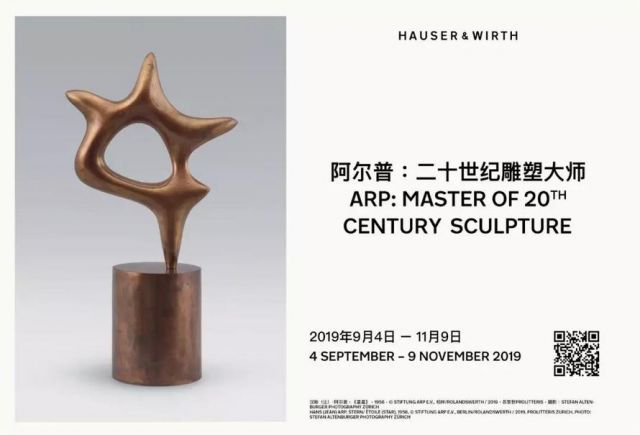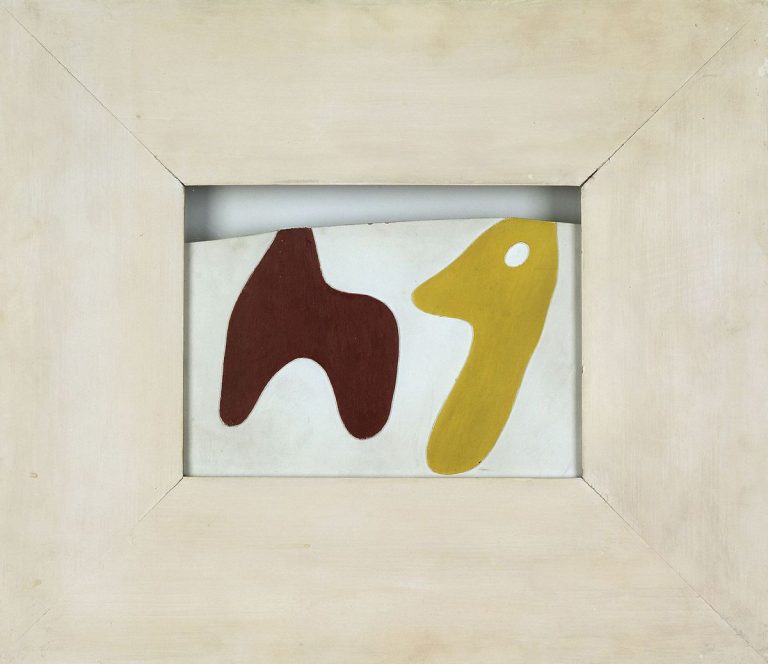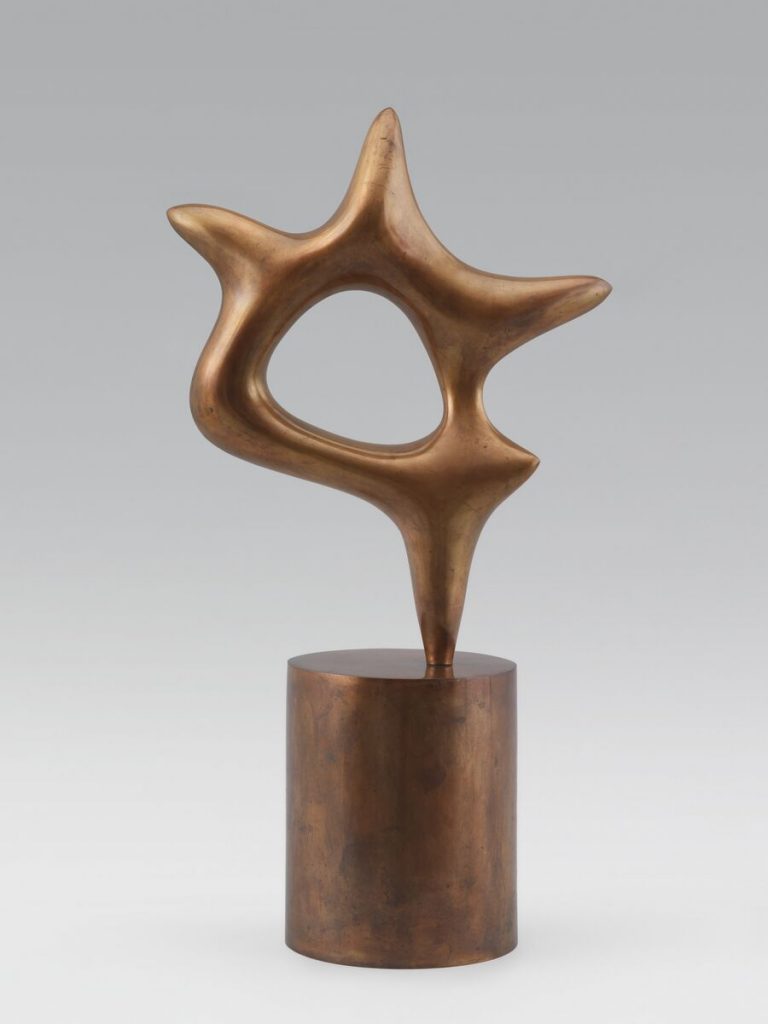
Hauser & Wirth Hong Kong presents the first solo exhibition in Greater China of one of the masters of 20th-century modern art: Hans (Jean) Arp (1886 – 1966) was at the forefront of the 20th-century avant garde, and associated strongly with Surrealism and the international Dada movement. Over a period of more than sixty years Arp produced an extraordinarily influential body of work that shifts fluidly between abstraction and representation, and between organic and geometric forms. The list of artists Arp befriended and collaborated with reads like a Who’s Who of the avant garde: Max Ernst, Joan Miró, Amedeo Modigliani, Wassily Kandinsky, Piet Mondrian, Sonia and Robert Delaunay, Francis Picabia, Paul Klee, Kurt Schwitters – to name just a few.
Born in 1886 in Strasbourg, Alsace, a historically embattled region bordered by France, Germany and Switzerland, Arp was raised speaking French, German and the Alsatian dialect. His hybrid cultural identity was formed during a long period of fraught nationalism, subsequently the artist refused to confine himself to a single language, national identity, artistic movement, or material. Much of his creative work seems intent on transcending boundaries, and the high quality of Arp’s creative output over decades is matched only by its sheer diversity: At the heart of Arp’s artistic triumph shines the organic beauty of his sculptures, but the artist first gained acclaim for his poetry in German and French, as well as his prints, books, drawings, fabric works, collages and his wood reliefs.

Arp, Chaise et bouteille (Chair and bottle), 1926; Cardboard and paint, 48.2×55.7×2.5cm ©Stiftung Arp e.V./ Licensed by ARS, NY and DACS, London; Courtesy Stiftung Arp e.V. and Hauser & Wirth
When World War I broke out in August 1914, Arp was living in Paris. In 1915 he went into exile in neutral Switzerland where he became a founding member of the radical Dada movement in Zurich in 1916. There he joined an international community of artists and intellectuals and he met fellow artist and his future wife, Sophie Taeuber. Her geometric works and their artistic collaboration had a lasting influence on his artistic development. Together they experimented with new materials and formats refusing any hierarchies of genres. At that time Arp started to create his own visual language, which he refined in the following years while living at numerous places in France and Switzerland. Instead of imitating nature he was looking for creative strategies analogous to the fascinating processes of nature. He pioneered the use of chance and in his collages, cut-out works and reliefs he generated multiple layers of meaning through their titles. Focusing his attention on everyday objects, in the 1920s Arp created his very own ‘object language’ using a nonsensical vocabulary of simple, reduced forms of bottles, forks, knives, clocks, ties, moustaches, lips, breasts and eggs which he placed in absurd juxtapositions on irregular backgrounds.
Spread over two floors, ‘Arp: Master of 20th Century Sculpture’ explores the development of the artist’s unique formal language in his early woodcuts, cardboard collages, drawings, wood reliefs, and in his bronze sculptures spanning the period from 1918 – 1965.
The early cardboard cut-out work ‘Chaise et bouteille / Stuhl und Flasche (Chair and bottle)’ (1926) stands as a remarkable example for Arp’s quirky play with words and forms, and his rejection of traditional painterly illusionism. While reintroducing traditional aspects of paintings, such as the rectangular format and the frame, Arp playfully destroys the illusionism by cutting through the pictorial support.

Arp, Stern (Star), 1956; Bronze, 63x35x17cm, ©Stiftung Arp e.V./ Licensed by ARS, NY and DACS, London Courtesy Stiftung Arp e.V. and Hauser & Wirth
In around 1930 Arp turned to sculpture. By transforming the flat, biomorphic shapes of his earlier reliefs into fully-fledged sculptural creations, Arp arrived at a language of organic forms – at once figurative and chimeric – that would serve as the origin of his art for the remaining three decades of his career. In an act of continuous metamorphosis that echoes the generative processes of nature itself, Arp recast these elemental motifs over and over in various media and new configurations.
Sculptures like ‘Wachstum / Croissance (Growth)’ (1938/1960, cast 2006) – an amorphous biomorphism made of smooth bronze – demonstrate Arp’s masterful ability to enliven form through sensually haptic, rounded contours. Skillfully blurring representation and abstraction, the conscious and the subconscious, the concrete and the creative, ‘Growth’ can be interpreted as a branch of a plant, uncoiling as it twirls upwards from its base.
Conceived within the last decade of Arp’s life, his expertly carved ‘Stern/ Étoile (Star)’ (1956, cast 1976) embodies the characteristic physical beauty of his work, displaying near perfect unblemished surfaces and smooth curvilinear forms. The ends of the sculpture are reminiscent of flickering flames while the captivating vacancy in the middle of the sculpture suggests eternity and transcendency. The bronze articulates an innate natural or spiritual order and rhythm that pulses through its curves and lines in a reaction to the creative energy and intuitive skill of the artist. He explained what was to become his consistent aesthetic:
‘I made my first experiments with free forms, I looked for new constellations of form such as nature never stops producing. I tried to make forms grow. I put my trust in the example of seeds, stars, clouds, plants, animals, men, and finally my own innermost being.’
Arp’s organic formal language has influenced artists over generations. His works can be found in numerous museum collections and major public spaces worldwide. He was awarded the Grand Prize for Sculpture at the Venice Biennale in 1954. The first Arp retrospective was held at the Museum of Modern Art in New York in 1958. Most recently, in 2018 the Nasher Sculpture Center in Dallas, TX organised the extensive solo exhibition ‘The Nature of Arp’ which travelled to the Peggy Guggenheim Collection in Venice, Italy.
About the exhibition
Opens on: Tuesday 3 September 2019, 6 – 8 pm
Duration: 4 Sep – 9 Nov 2019
Venue: Hauser & Wirth Hong Kong
Courtesy of Hauser & Wirth Hong Kong, for further information please visit www.hauserwirth.com.




























